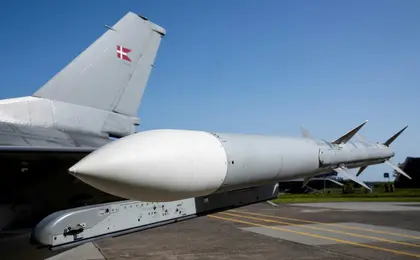In the latest installment of saber-rattling, the Kremlin has insisted that Russia will regard Western F-16 fighter jets sent to Ukraine as a “nuclear” threat because of their capacity to carry atomic weapons.
Speaking on Thursday, July 13, Foreign Minister Sergei Lavrov was responding to an announcement made at yesterday’s NATO summit that the Netherlands and Denmark are leading a plan to train Ukrainian pilots on using the US-made aircraft as part of an 11-nation coalition beginning in August.
JOIN US ON TELEGRAM
Follow our coverage of the war on the @Kyivpost_official.
“Russia cannot ignore the ability of these aircraft to carry nuclear weapons. No amount of assurances will help here,” Lavrov was quoted as saying by the Russian foreign ministry.
“In the course of combat operations, our servicemen are not going to sort out whether each particular aircraft of this type is equipped to deliver nuclear weapons or not.
“We will regard the very fact that the Ukrainian armed forces have such systems as a threat from the West in the nuclear sphere.”
So is Lavrov correct and Ukrainian F-16s pose a specific nuclear threat to Russia?
In short, any aircraft including the ones Ukraine already uses could be equipped with nuclear weapons so the F-16s pose no additional risk to Russia.
Furthermore, there are quite a few other things that would have to happen in order for them to be as deadly as Lavrov is trying to make out.

‘A Man of Character’ – Ukraine at War Update for Jan. 10
Over to Kyiv Post’s resident aircraft expert, former F-16 pilot and now-editor, Christopher Stewart:
Any aircraft is actually nuclear weapons capable. A blimp, dirigible, zeppelin or hot air balloon is nuclear weapons capable. The question is whether a controlled nuclear weapon can be employed based on using a special weapon where the device is manufactured with specific requirements to arm the warhead.
The casual usage of the phrase usually refers to being capable of delivering nuclear weapons with a lot of safety and security-based armament procedures. This implies that the device is one that has such safeguards designed into it so it cannot be used without permission.
The “secret nuclear codes” are called permissive action links (PAL) and require certain inputs to be given to the weapon before the warhead can be armed. It’s not just a switch to be flipped and a button to be pressed. In fact, without PAL you can drop a nuclear weapon, it just will not function.
This, again, presumes that the nuclear weapon has such safeguards built in, usually because the government procuring and controlling the weapon was a signatory party to international treaties. If a rogue country makes a weapon and doesn’t build in special safeguards, it is nuclear capable.
Case Study: The B61
The nuclear weapon most commonly available for US fighter aircraft use is the B61. With a yield from 0.3 kt (equivalent kilotons of TNT) to 340 kt weapon could be carried by the F-15E, F-16, F/A-18, F/A-22, F-35, AV-8B. Retired aircraft that could carry the B61 included the A-4, A-6, F-4, F-100, F-105 and F-111 (and likely the F-117, unconfirmed).
Of course, the US bomber fleet of B-52s, B-1s and B-2s, and the new B-21 all have the capability to use the B61 along with much larger yield nuclear weapons such as the B83. These are the only aircraft deliverable nuclear bombs currently in the US inventory.
The United Kingdom and France have their own nuclear weapons programs, though the UK has been part of a nuclear sharing program in the past.
Other NATO countries involved in the nuclear sharing program, in which the US keeps control of the PAL codes, include Belgium, Germany, Italy, the Netherlands and Turkey.
For example, NATO aircraft that can use the B61 include Germany’s Tornado IDS and Berlin plans to supplant or replace the older aircraft with its purchase of F-35s.
So there you have it – more saber-rattling and little actual sense from the Kremlin.
You can also highlight the text and press Ctrl + Enter










